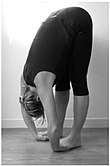Uttanasana
Uttanasana (Sanskrit: उत्तानासन; IAST: uttānāsana) or Standing Forward Bend,[1] with variants such as Padahastasana where the toes are grasped, is a standing forward bending asana in modern yoga as exercise.

Etymology and origins
The name comes from the Sanskrit words उत्तान uttāna, "intense stretch";[2] and आसन; āsana, "posture" or "seat".[3]
The pose is a modern one, first seen in the 20th century. A pose with the name Uttānāsana is illustrated in the 19th century Sritattvanidhi but it is quite different from the modern pose (lying on the back, with elbows touching the knees and the hands behind the neck).[4] The modern pose is described in Krishnamacharya's 1934 Yoga Makaranda,[5] and in the works of his pupils, B. K. S. Iyengar's 1966 Light on Yoga[6] and Pattabhi Jois's Ashtanga Vinyasa Yoga.[2][7] Theos Bernard however illustrates the related pose "Padhahasthasana" (sic) in his 1944 report of his experience of hatha yoga on the border of India and Tibet, suggesting the existence of a separate tradition.[8]
Description
The pose is entered from the standing position of Tadasana, bending forward at the hips until the palms can be placed on the floor, ultimately behind the heels.[6]
Variations

Variations include:
- Ardha Uttanasana is a halfway stage, the trunk horizontal and the palms resting on the calves.[9]
- Niralamba Uttanasana has the hands touching the waistband rather than reaching down.[10]
- Padahastasana has the hands under the toes and feet, palms up.[11]
See also
- Paschimottanasana, a sitting forward bend
References
- "Standing Forward Bend". Yoga Journal. Retrieved 11 April 2011.
- "Uttanasana A". Ashtanga Yoga. Retrieved 11 April 2011.
- Sinha, S. C. (1996). Dictionary of Philosophy. Anmol Publications. p. 18. ISBN 978-81-7041-293-9.
- Sjoman, Norman E. (1999) [1996]. The Yoga Tradition of the Mysore Palace. Abhinav Publications. pp. 69, plate 1 (pose 2). ISBN 81-7017-389-2.
- Krishnamacharya, Tirunamalai (2006) [1934]. Yoga Makaranda. Translated by Lakshmi Ranganathan; Nandini Ranganathan. pp. 51, 55–56.
- Iyengar, B. K. S. (1979) [1966]. Light on Yoga: Yoga Dipika. Unwin Paperbacks. pp. 91–93. ISBN 978-1855381667.
- Singleton, Mark (2010). Yoga body : the origins of modern posture practice. Oxford University Press. pp. 175–210. ISBN 978-0-19-539534-1. OCLC 318191988.
- Bernard, Theos (2007) [1944]. Hatha yoga : the report of a personal experience. Edinburgh: Harmony. p. 132. ISBN 978-0-9552412-2-2. OCLC 230987898.
- Calhoun, Yael; Calhoun, Matthew R.; Hamory, Nicole (2008). Yoga for Kids to Teens. Sunstone Press. p. 167. ISBN 978-0-86534-686-4.
- Ramaswami, Srivatsa; Krishnamacharya, Tirumalai (2005). The complete book of vinyasa yoga: an authoritative presentation, based on 30 years of direct study under the legendary yoga teacher Krishnamacharya. Da Capo Press. p. 16. ISBN 978-1-56924-402-9.
- "Witold Fitz-Simon - Padahastasana". Retrieved 9 April 2011.
Further reading
- Iyengar, B. K. S. (1 October 2005). Illustrated Light On Yoga. HarperCollins. ISBN 978-81-7223-606-9.
- Saraswati, Swami Janakananda (1 February 1992). Yoga, Tantra and Meditation in Daily Life. Weiser Books. ISBN 978-0-87728-768-1.
- Saraswati, Swami Satyananda (2003). Asana Pranayama Mudra Bandha. Nesma Books India. ISBN 978-81-86336-14-4.
- Saraswati, Swami Satyananda (January 2004). A Systematic Course in the Ancient Tantric Techniques of Yoga and Kriya. Nesma Books India. ISBN 978-81-85787-08-4.
_from_Jogapradipika_1830_(detail).jpg)
